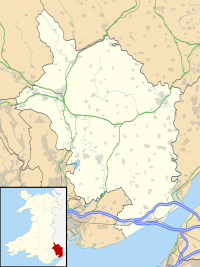Church of All Saints, Kemeys Commander
| All Saints Church | |
|---|---|
| Church of All Saints | |
 The entrance and bell gable | |
 All Saints Church Location in Monmouthshire | |
| Coordinates: 51°44′17″N 2°56′39″W / 51.7381°N 2.9442°W | |
| Location | Kemeys Commander, Monmouthshire |
| Country | Wales |
| Denomination | Church in Wales |
| Website | Official website |
| History | |
| Status | Parish church |
| Founded | c. 13th century |
| Architecture | |
| Functional status | Active |
| Heritage designation | Grade II* |
| Designated | 18 November 1980 |
| Architectural type | Church |
| Administration | |
| Parish | Bettws Newydd and Kemeys Commander |
| Deanery | Raglan/Usk |
| Archdeaconry | Monmouth |
| Diocese | Monmouth |
| Clergy | |
| Rector | The Reverend K J Hasler |
The Church of All Saints, Kemeys Commander, Monmouthshire, Wales, is a parish church with its origins in the 13th century. It is a Grade II* listed building.
History[]
The hamlets of Kemeys Commander and formed part of the Monmouthshire estates of the Knights Templar.[1] The Templars administered their holdings through commandery, accounting for the name of the hamlet. A reference to a church on the site dates from the 13th century, but the present building was constructed in the 15th century.[1] The Lordship of Kemeys dates from the Middle Ages and was held by the Kemeys family until the estate was sold in the early 18th century.[2]
The church was restored by Richard Creed in the late 19th century.[3] At the time of the restoration, the vicar was The Rev. Herbert Sheppard M.A., of Clare College, Cambridge.[4]
Architecture and description[]
The church is built of local limestone in the Perpendicular style.[5] The entrance is through a timber porch[5] and under a bell gable.[6]
The building has suffered from subsidence and the bell gable is off-vertical.[7]
The church retains its original medieval rood screen and rood beam, one of few churches in southeast Wales that do so.[8][9]
Notes[]
- ^ a b Good Stuff. "Church of All Saints, Gwehelog Fawr, Monmouthshire". Britishlistedbuildings.co.uk. Retrieved 2017-03-31.
- ^ Newman 2000, p. 260.
- ^ "Listed Buildings - Full Report - HeritageBill Cadw Assets - Reports". Cadwpublic-api.azurewebsites.net. Retrieved 2017-03-31.
- ^ "KELLY'S DIRECTORY OF MONMOUTHSHIRE, 1901". Freepages.genealogy.rootsweb.ancestry.com. Retrieved 2017-03-31.
- ^ a b Newman 2000, p. 259.
- ^ "All Saints, Kemeys Commander". Coflein. 2002-12-13. Retrieved 2017-03-31.
- ^ "GGAT01812g". Cofiadurcahcymru.org.uk. Retrieved 2017-03-31.
- ^ Newman 2000, p. 25: "At Kemeys Commander the screen and rood beam remain, and were clearly constructed together with the fabric of the little church".
- ^ Kenyon, John R.; Williams, Diane M. (2006). Cardiff: Architecture and Archaeology in the Medieval Diocese of Llandaff. British Archaeological Association. ISBN 978-1-904350-80-4.
reprinted as Kenyon, John R.; Williams, Diane M. (2020). Cardiff : architecture and archaeology in the medieval diocese of Llandaff. Abingdon, Oxon: Routledge. ISBN 9781000161076.
References[]
- Newman, John (2000). Gwent/Monmouthshire. The Buildings of Wales. London: Penguin. ISBN 0-14-071053-1.

- Grade II* listed churches in Monmouthshire
- History of Monmouthshire
- Church in Wales church buildings
- 14th-century church buildings in Wales
